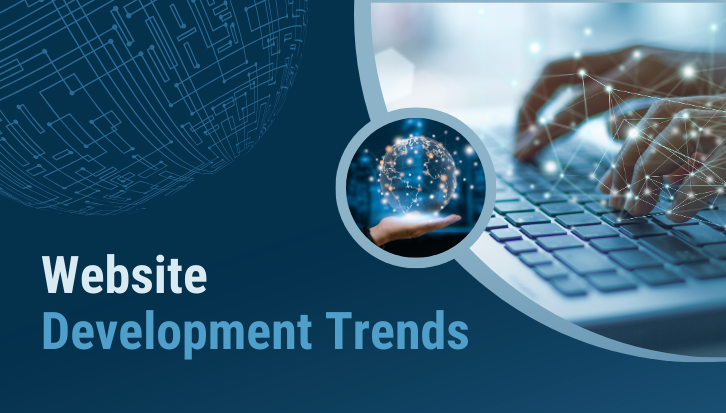Office Address
DSB 267 FF, OPPOSITE AGGARSAIN BHAWAN HISAR 125001
Phone Number
+91 90344-38894
+91 81681 - 38304
DSB 267 FF, OPPOSITE AGGARSAIN BHAWAN HISAR 125001
+91 90344-38894
+91 81681 - 38304

In the fast-paced world of website development, staying abreast of the latest trends is essential for creating engaging and high-performing websites. As we progress through 2024, several key trends redefine how websites are built and experienced. From advanced technologies like Progressive Web Apps (PWAs) and artificial intelligence to evolving design philosophies such as dark mode and minimalist aesthetics, these trends are shaping the future of the web. This blog explores these latest developments, offering insights into how they can be leveraged to enhance user experience and website functionality.

1. Progressive Web Apps (PWAs)
Progressive Web Apps represent a significant advancement in web technology, merging the best features of web and mobile applications. PWAs provide a native app-like experience directly within a web browser, offering benefits such as offline access, push notifications, and fast load times. They are designed to be reliable, responsive, and engaging, making them a popular choice for businesses aiming to deliver a seamless user experience without developing separate mobile apps. By incorporating PWAs into your website strategy, you can ensure that users enjoy a smooth and consistent experience across all devices.
2. Artificial Intelligence and Machine Learning
Artificial intelligence(AI) and machine learning are revolutionizing website development services in Hisar by introducing smarter, more personalized interactions. AI-driven tools are increasingly being used to enhance user engagement through features such as chatbots, personalized content recommendations, and predictive analytics. These technologies help automate repetitive tasks, provide valuable insights, and tailor user experiences based on behavior and preferences. Integrating AI into your website can improve functionality, streamline operations, and offer a more customized user experience.
3. Voice User Interface (VUI)
With the growing popularity of voice-activated devices like smart speakers and virtual assistants, voice user interfaces (VUI) are becoming integral to web design. VUI enables users to interact with websites using voice commands, making navigation more intuitive and accessible. Implementing voice search and voice commands can enhance user experience, particularly for those with disabilities or those who prefer hands-free interactions. As voice technology continues to evolve, incorporating VUI into your website can help you stay ahead of the curve and meet the demands of modern users.
4. Dark Mode
Dark mode has gained widespread popularity due to its modern aesthetic and benefits for reducing eye strain. Many websites and applications now offer a dark mode option, allowing users to switch between light and dark themes based on their preferences. This trend not only provides a visually appealing design but also enhances user comfort during prolonged browsing sessions. By adopting dark mode, you can offer a more flexible and user-friendly experience that caters to diverse user needs.
5. Advanced Motion UI
Advanced motion UI design trend that focuses on incorporating dynamic animations and transitions into websites. Motion UI enhances user experience by creating visually engaging and interactive elements that guide users through content. From subtle hover effects to elaborate animations, motion UI can add a layer of sophistication and interactivity to your website. By using motion UI strategically, you can capture user attention, improve navigation, and create a more immersive web experience.
6. Minimalist and Simplified Design
Minimalist design continues to be a dominant trend, emphasizing simplicity and clarity. A minimalist approach involves using clean layouts, ample white space, and straightforward navigation to create a more focused and user-friendly experience. This design philosophy helps reduce clutter, making it easier for users to find and interact with content. By adopting a minimalist design, you can enhance the overall usability of your website designing and create a visually appealing environment that resonates with users.
7. Mobile-First Design
As mobile internet usage continues to outpace desktops, adopting a mobile-first designapproach is crucial. The mobile-first designprioritizes the needs of mobile users, ensuring that websites are optimized for smaller screens, touch interactions, and varying network conditions. This approach involves designing for mobile devices first and then adapting the design for larger screens. By focusing on mobile-first design, you can ensure that your website delivers a seamless experience across all devices and meets the growing demand for mobile accessibility.

8. Cybersecurity Enhancements
With the increasing frequency of cyber threats, cybersecurityhas become a top priority in website development. Implementing robust security measures such as Https, data encryption, and regular security audits is essential for protecting user data and maintaining trust. Enhancing cybersecuritynot only helps safeguard against potential vulnerabilities but also demonstrates a commitment to user privacy and data protection. By prioritizing security in your website development process, you can build a safer online environment and mitigate the risks associated with cyber threats.
Conclusion
Keeping up with the latest trends in website development is essential for creating modern, effective, and engaging websites. By embracing innovations such as Progressive Web Apps, AI, voice interfaces, and minimalist design, you can ensure that your websitemeets the evolving expectations of users and stands out in the competitive digital landscape. Additionally, incorporating trends like dark mode, advanced motion UI, mobile-first design, and enhanced cybersecuritywill help you deliver a top-notch user experience and address key challenges in web development. Stay ahead of the curve by integrating these trends into your website strategy to achieve greater success and user satisfaction.